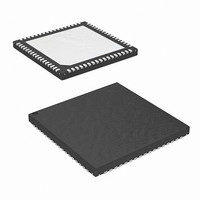KAD2708L-10Q68 Intersil, KAD2708L-10Q68 Datasheet - Page 15

KAD2708L-10Q68
Manufacturer Part Number
KAD2708L-10Q68
Description
IC ADC 8BIT 105MSPS SGL 68-QFN
Manufacturer
Intersil
Series
FemtoCharge™r
Datasheet
1.KAD2708L-35Q68.pdf
(16 pages)
Specifications of KAD2708L-10Q68
Number Of Bits
8
Sampling Rate (per Second)
105M
Data Interface
Parallel
Number Of Converters
1
Power Dissipation (max)
196mW
Voltage Supply Source
Single Supply
Operating Temperature
-40°C ~ 85°C
Mounting Type
Surface Mount
Package / Case
68-VQFN Exposed Pad, 68-HVQFN, 68-SQFN, 68-DHVQFN
For Use With
KDC2708LEVAL - DAUGHTER CARD FOR KAD2708
Lead Free Status / RoHS Status
Lead free / RoHS Compliant
Layout Considerations
Split Ground and Power Planes
Data converters operating at high sampling frequencies
require extra care in PC board layout. Many complex board
designs benefit from isolating the analog and digital
sections. Analog supply and ground planes should be laid
out under signal and clock inputs. Locate the digital planes
under outputs and logic pins. Ground planes, if separated,
should be joined at the exposed paddle under the chip.
Clock Input Considerations
Use matched transmission lines to the inputs for the analog
input and clock signals. Locate transformers, drivers and
terminations as close to the chip as possible.
Bypass and Filtering
Bulk capacitors should have low equivalent series resistance.
Tantalum is a good choice. For best performance, keep
ceramic bypass capacitors very close to device pins. Longer
traces increase inductance, resulting in diminished dynamic
performance and accuracy. Make sure that connections to
ground are direct and low impedance.
LVDS Outputs
Output traces and connections must be designed for 50Ω
(100Ω differential) characteristic impedance. Keep traces
direct, and minimize bends where possible. Avoid crossing
ground and power-plane breaks with signal traces.
Unused Inputs
The RST and 2SC inputs are internally pulled up and can be
left open-circuit if not used.
CLKDIV is internally pulled low, which divides the input clock
by two.
VREFSEL is internally pulled up. It must be held low for
internal reference, but it can be left open for external
reference.
Definitions
Analog Input Bandwidth is the analog input frequency at
which the spectral output power at the fundamental
frequency (as determined by FFT analysis) is reduced by
3dB from its full-scale, low-frequency value. This is also
referred to as Full Power Bandwidth.
Aperture Delay or Sampling Delay is the time required
after the rise of the clock input for the sampling switch to
open, at which time the signal is held for conversion.
Intersil products are sold by description only. Intersil Corporation reserves the right to make changes in circuit design, software and/or specifications at any time without
notice. Accordingly, the reader is cautioned to verify that data sheets are current before placing orders. Information furnished by Intersil is believed to be accurate and
reliable. However, no responsibility is assumed by Intersil or its subsidiaries for its use; nor for any infringements of patents or other rights of third parties which may result
from its use. No license is granted by implication or otherwise under any patent or patent rights of Intersil or its subsidiaries.
All Intersil U.S. products are manufactured, assembled and tested utilizing ISO9000 quality systems.
Intersil Corporation’s quality certifications can be viewed at www.intersil.com/design/quality
For information regarding Intersil Corporation and its products, see www.intersil.com
15
KAD2708L
Aperture Jitter is the RMS variation in aperture delay for a
set of samples.
Clock Duty Cycle is the ratio of the time the clock wave is at
logic high to the total time of one clock period.
Differential Non-Linearity (DNL) is the deviation of any
code width from an ideal 1 LSB step.
Effective Number of Bits (ENOB) is an alternate method of
specifying Signal to Noise-and-Distortion Ratio (SINAD). In
dB, it is calculated as: ENOB = (SINAD - 1.76)/6.02.
Integral Non-Linearity (INL) is the deviation of each individual
code from a line drawn from negative full-scale (1/2 LSB below
the first code transition) through positive full-scale (1/2 LSB
above the last code transition). The deviation of any given code
from this line is measured from the center of that code.
Least Significant Bit (LSB) is the bit that has the smallest
value or weight in a digital word. Its value in terms of input
voltage is VFS/(2N-1) where N is the resolution in bits.
Missing Codes are output codes that are skipped and never
appear at the ADC output. These codes cannot be reached
with any input value.
Most Significant Bit (MSB) is the bit that has the largest
value or weight. Its value in terms of input voltage is VFS/2.
Pipeline Delay is the number of clock cycles between the
initiation of a conversion and the appearance at the output
pins of the corresponding data.
Power Supply Rejection Ratio (PSRR) is the ratio of a
change in power supply voltage to the input voltage
necessary to negate the resultant change in output code.
Signal to Noise-and-Distortion (SINAD) is the ratio of the
RMS signal amplitude to the RMS sum of all other spectral
components below one-half the clock frequency, including
harmonics but excluding DC.
Signal-to-Noise Ratio (SNR) (without Harmonics) is the
ratio of the RMS signal amplitude to the RMS sum of all
other spectral components below one-half the sampling
frequency, excluding harmonics and DC.
Spurious-Free-Dynamic Range (SFDR) is the ratio of the
RMS signal amplitude to the RMS value of the peak spurious
spectral component. The peak spurious spectral component
may or may not be a harmonic.
Two-Tone SFDR is the ratio of the RMS value of either input
tone to the RMS value of the peak spurious component. The
peak spurious component may or may not be an IMD product.
April 14, 2011
FN6813.1









